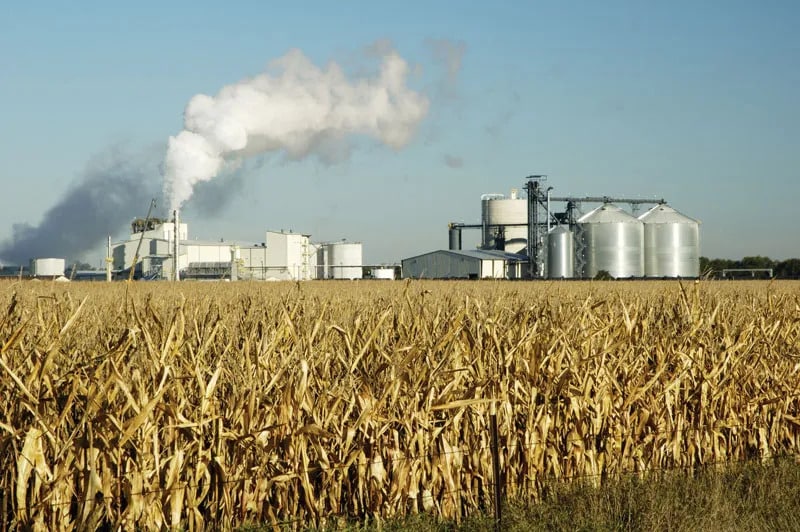What’s in today’s article?
- Why in News?
- What is Biofuel?
- What are the Different Generations of Biofuel?
- What is Ethanol Blending?
- How is Ethanol Produced?
- What the Benefits of Ethanol Blending?
- India’s Biofuel Policy
- News Summary
Why in news?
- In order to move faster towards its clean energy goal, India will set-up many bio-ethanol plants across the country under the cooperative sector.
What is Biofuel?
- Biofuel is a fuel that is produced over a short time span from biomass, rather than by the very slow natural processes involved in the formation of fossil fuels, such as oil.
- Since biomass can be used as a fuel directly (e.g., wood logs), some people use the words biomass and biofuel interchangeably.
- However, the word biofuel is usually reserved for liquid or gaseous fuels, used for transportation.
- Most of biofuel consumption occurs as a blend with refined petroleum products such as gasoline, diesel fuel, heating oil, and kerosene-type jet fuel.
- However, some biofuels do not require blending with their petroleum counterparts and are referred to as drop-in biofuels.
- The most common biofuels now are –
- Bioalcohols such as ethanol, propanol, and butanol (a substitute for petrol/gasoline);
- Biodiesel (a substitute for diesel);
- Bio-oils (substitutes for kerosene).
What are the Different Generations of Biofuel?
Image Caption: Biofuel Generations
- Biofuels are also divided into four categories depending on their origin and production technologies.
- First generation –
- 1G biofuels are produced from consumable food items containing starch (rice and wheat) and sugar (beets and sugarcane) for bioalcohols, or vegetable oils for biodiesel.
- However, the yields of 1G biofuels are low and can have negative impacts on food security.
- Second generation –
- 2G biofuels are mainly obtained from non-food feedstocks such as forest/industry/agricultural wastes and waste or used vegetable oils.
- Third generation –
- 3G biofuels, known as ‘algae fuel’, are derived from algae in the form of both, biodiesel and bioalcohols.
- Although the yield of 3G biofuels is approximately 10 times higher than 2G biofuels, producing adequate algal biomass and scaling up extraction techniques are as yet unresolved challenges.
- Fourth generation –
- Like the third generation, 4G biofuels are made using non-arable land.
- However, unlike the third, they do not need the destruction of biomass.
- This class of biofuels includes electro fuels and photo-biological solar fuels.
What is Ethanol Blending?
- Ethanol is a biofuel, naturally produced by the fermentation of sugars by yeasts or by petrochemical processes like ethylene hydration.
- Ethanol is high in oxygen content, allowing an engine to more thoroughly combust fuel.
- In ethanol blending, a blended motor fuel containing ethyl alcohol derived from agricultural products is blended with petrol specifically.
How is Ethanol Produced?
- In India, the nodal department for the promotion of fuel-grade ethanol-producing distilleries is the Department of Food and Public Distribution (DFPD).
- Ethanol is produced or procured from sugarcane-based raw materials which are – C & B heavy molasses, sugarcane juice, sugar syrup, surplus rice with Food Corporation of India (FCI) and maize.
- A paper released by the NITI Aayog stated, that in 2019, over 110 billion liters of ethanol fuel was produced globally.
- The US and Brazil account for 84% of the global production followed by the European Union, China, India, Canada and Thailand.
What are the Benefits of Ethanol Blending?
- Presently, India imports over 85 per cent of its oil requirement and ethanol blending could help in reducing dependency on petroleum.
- In 2020-21, the net import of petroleum in India was 185 million tones at USD 551 billion.
- Thus, ethanol blending can help in saving billions of dollars for the country and reduce import dependency.
- Also, ethanol is a less polluting fuel and equally efficient at a lower cost than petrol.
India’s Biofuel Policy
- In 2021-22, the Central government amended the Biofuel Policy (2018) to set a target of country-wide blending rates of 20% ethanol and 5% biodiesel by 2025.
- According to the Roadmap for ethanol blending in India 2020-2025 report from NITI Aayog, India will need to increase ethanol production capacity from the expected 3.3 billion liters (in 2020–2021) to at least 10.2 billion liters (5.5 billion liters from sugarcane and 4.7 billion liters from grains) by 2025.
News Summary
- Union Ministry of Cooperation recently said that the production of ethanol was going to change the economy of the petroleum sector of the country in the coming days.
- The ministry added that ethanol blending will save about Rs 1 lakh crore in foreign exchange reserves.
- In September 2022, foundation stone was laid for Krishak Bharti Cooperative Limited (KRIBHCO) Hazira’s bio-ethanol project.
- The plant will use maize as bio resource and the project will also provide raw material for high protein animal feed, fisheries and poultry.
- Union Minister for Cooperation Shri Amit Shah said that India will set-up many such bio-ethanol plants across the country under the cooperative sector.
- The projects can include renewable energy, clean transportation and green buildings, among others.
Q1) What is Biofuel best used for?
Most biofuels are used as transportation fuels, but they may also be used for heating and electricity generation. Gaseous fuels produced from biomass that are used directly as a gas or converted to liquid fuels may qualify for use in government programs that promote or require use of biofuels.
Q2) What are the environmental benefits of Biofuels?
When burned, pure biofuels generally produce fewer emissions of particulates, sulfur dioxide, and air toxics than their fossil-fuel derived counterparts. Biofuel-petroleum blends also generally result in lower emissions relative to fuels that do not contain biofuels.
Source: Bio-ethanol plants to boost India’s drive to meet clean energy target | The Hindu
Last updated on December, 2025
→ Check out the latest UPSC Syllabus 2026 here.
→ Join Vajiram & Ravi’s Interview Guidance Programme for expert help to crack your final UPSC stage.
→ UPSC Mains Result 2025 is now out.
→ UPSC Notification 2026 is scheduled to be released on January 14, 2026.
→ UPSC Calendar 2026 is released on 15th May, 2025.
→ The UPSC Vacancy 2025 were released 1129, out of which 979 were for UPSC CSE and remaining 150 are for UPSC IFoS.
→ UPSC Prelims 2026 will be conducted on 24th May, 2026 & UPSC Mains 2026 will be conducted on 21st August 2026.
→ The UPSC Selection Process is of 3 stages-Prelims, Mains and Interview.
→ UPSC Result 2024 is released with latest UPSC Marksheet 2024. Check Now!
→ UPSC Prelims Result 2025 is out now for the CSE held on 25 May 2025.
→ UPSC Toppers List 2024 is released now. Shakti Dubey is UPSC AIR 1 2024 Topper.
→ UPSC Prelims Question Paper 2025 and Unofficial Prelims Answer Key 2025 are available now.
→ UPSC Mains Question Paper 2025 is out for Essay, GS 1, 2, 3 & GS 4.
→ UPSC Mains Indian Language Question Paper 2025 is now out.
→ UPSC Mains Optional Question Paper 2025 is now out.
→ Also check Best IAS Coaching in Delhi

















